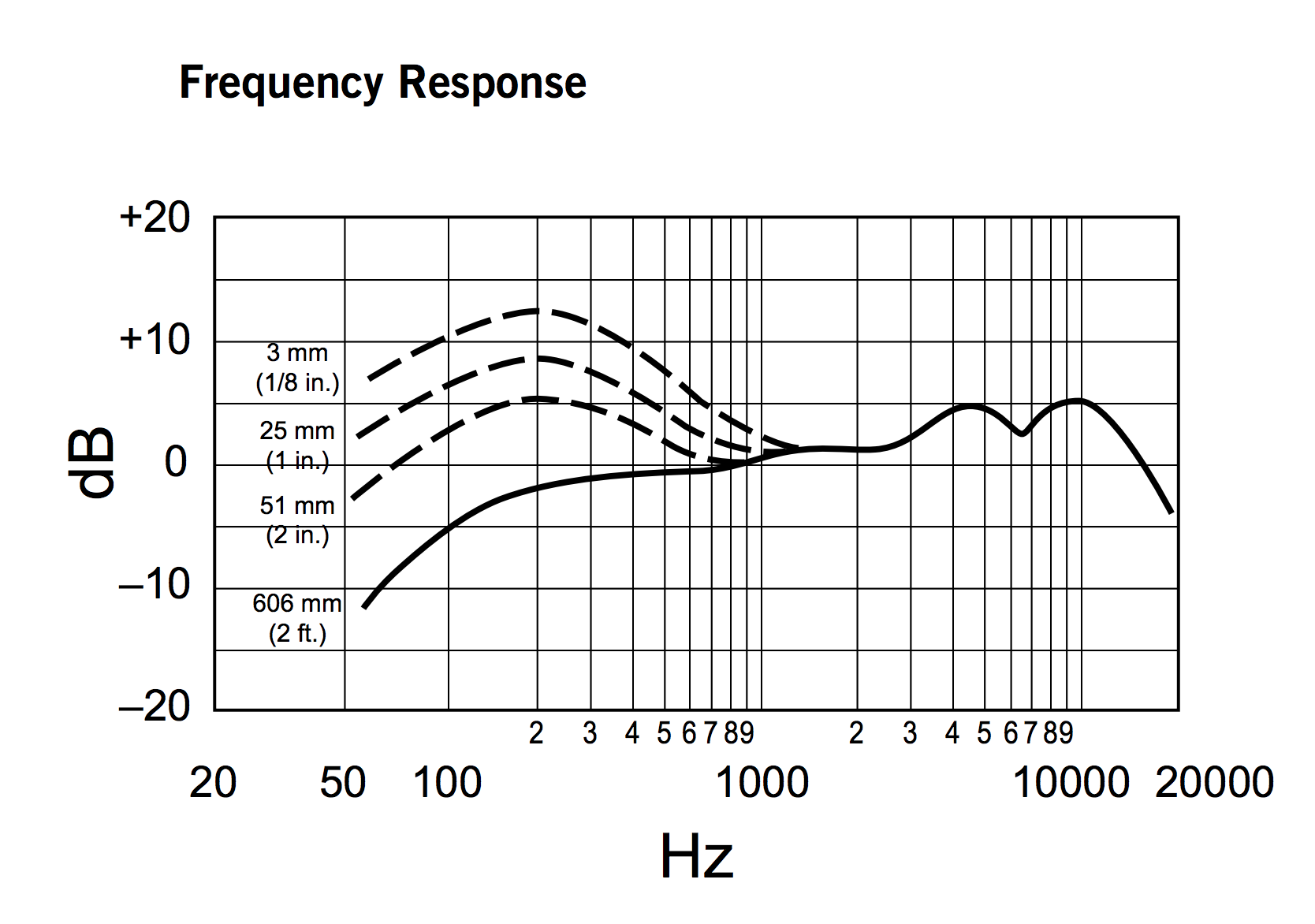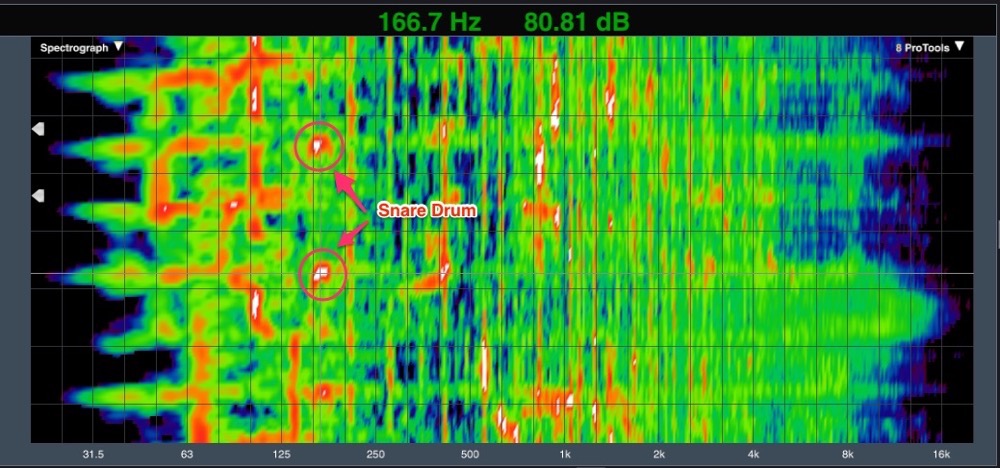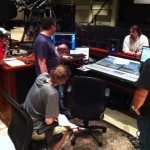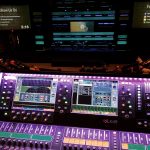
Neutered PA’s, Lipstick Residue, and the Bethel Snare
I’m a big fan of linear PA’s, but as I’ve written about in the past, a flat line in a measurement rig does not always correlate to a linear loudspeaker response. I feel like a lot of system engineers and tuners don’t quite understand this, though, and as a result I run into a lot of neutered PA’s in the wild where all the guts and oomph have been EQ’ed out of the system. I’ve also run into another side of this where a system tech will defend this approach saying if he doesn’t do this I’ll have to EQ the vocal mic a lot. So let’s look at this.

This is a photo of a properly used live vocal mic by a female vocalist. Some of you are probably thinking “ewwwwww” at the lipstick residue, but to me it’s a sign she was right on top of the mic where I’d like her. Plus, a little bit of Microphome will clean that right off.
The reason I want vocalists that close in a live scenario is because it increases the amount of the voice (aka signal) in the mic relative to the other acoustic stuff like acoustic cymbals, backline, PA, etc. on stage (aka noise) in the mic. So when a vocalist gets right on top of the mic, I get a cleaner vocal at the microphone with increased gain before feedback.
Now, here is the frequency response of a Shure Beta 58a courtesy of Shure. Take a close look at the lower frequencies.

Shure Beta 58a Frequency Response courtesy of Shure
Those dashes represent how the proximity effect of the microphone affects its frequency response. Proximity Effect is the term we use to describe how a directional microphone’s frequency response changes depending on the distance of the microphone to the source. We can see here that as the distance from the source decreases, we have a rise in frequencies below 1k. The 3mm response curve is quite representative of a vocalist who is right on the mic. Notice that there is a very wide bump of about 15 dB centered at 200Hz with that 3mm response curve. Read that again:
15 dB!!
So if I want to remove all the proximity effect on a Shure Beta58a, I’m going to need to cut 15 dB at 200 Hz with a wide Q. In most cases, I’ll want to remove a portion of that proximity effect, but I don’t want to remove it all because that response helps give the vocal body and warmth. Plus, I want to leave some of it in because it helps keep the lower frequencies of the voice balanced relative to the upper-mids and high frequencies where the mic has ~5 dB of gain.
What I’m really trying to get at, though, is it doesn’t alarm or bother me one bit if I have to pull 10 dB out of a Beta58a because I understand how the microphone works both from experience as well as looking at the frequency response chart. Based on these things I know I should have to EQ that area quite a bit.
There’s a problem, though, when someone EQ’s the PA to account for the response of a single mic like a Beta58 on a vocal: Not everything in the mix is a vocal on a Beta58.
When all that lower frequency energy gets taken out of the PA, it affects EVERY instrument. So that’s cutting out the fundamentals in the guitars, keyboards, bass, and SNARE DRUM. For those who don’t understand what the fundamental is, it’s basically the note of the instrument. The fundamentals are the meat and potatoes of what makes the sound of that instrument work which is why they’re called the fundamentals.
Speaking of snare drums, I was having a conversation with a great drummer not too long ago who was a little confused regarding the exaggerated use of the Waves Torque plug-in in some of the churches he’s playing in. He was talking about how some FOH engineers are trying to get that Bethel snare sound, but in the process they’re taking his already detuned snare and creating strange artifacts or sometimes even making it sound unlike any snare drum at all.
So let’s take a look at something. I ran Raise A Hallelujah off Bethel’s latest release into Smaart and took a screenshot which you can see below.

I marked the snare hits here which have a lot of energy around 160-170 Hz. That’s on the lower side for a snare fundamental, but it’s not unusual for me to boost around there or even lower on a snare drum when I’m trying to beef it up. I think, in the context of what I’m trying to get at today and my drummer friend’s concerns, a lot of guys might be reaching for the wrong tool to solve an issue that isn’t even mix related. Torque or some other form of pitch modifying processor can do some cool things and be a great tool, but a plug-in isn’t really going to help if your system has been neutered to begin with.
So how do you know if your system needs some meat put back into it? That’s a tough question to answer because there is definitely some subjectivity to what a PA should actually sound like or rather, how it should reproduce music, speech, and everything else you put into it. Your best bet would be to take some good measurements of your system or better yet bring in an expert like me to give things an evaluation. If you want to check on your own, here’s something you can try, though.
Take a look at the frequency response of your favorite directional live vocal mic and check out what the proximity effect on it does to the response. If there’s no data available on the proximity effect response, use a mic like a Beta58a. Have a friend to take that mic on stage and have them get right on top of it and talk into it. Now, flatten the EQ and turn on a filter centered at the peak of the proximity effect with a wide-ish Q and pull out at least half of what the bump is. For example, on a Beta58a I’d try taking about 8 dB out. If his/her voice or vocal gets too thin from taking that much out, you might have a neutered PA that may be affecting how you and your team are mixing on it. I say “might” because there could be other factors at play like processing somewhere else in your signal chain along with your own personal tastes.
One way or the other, if you’d like to know for sure and get some help with evaluating your PA or even re-tuning it, I’d love to hear from you. Please message me through my Contact page and let me know how I can help. I still have some openings in my schedule this year if you’d like to have me look at things before your big Christmas services.

 Previous Post
Previous Post Next Post
Next Post



Interesting observation! Gotta love the power of the proximity effect.
At my church, I think we may have a case of the opposite happening at many of our campuses. I work on our Creative team as a sound designer, and a good majority of our video content ends up playing at every campus as well as online. I find that using Sonarworks Reference helps me greatly, however in disabling the correction and trying to simulate the average campus venue PA system, I’ve found that there’s a +12 dB bump centered around 90-100 Hz. Various venues (some more than others) have complained about the amount of EQ they have to do to compensate for the “muddiness” inherent in my mixes while being played through their PA systems. As I’ve thought about this, I believe this to be because the PA systems’ tuning. Why they’re tuned that way? I think it’s to allow for more headroom from the low end in the mix signal on the console, which is then boosted in the PA. Our worship culture is very drum and bass heavy, so it seems to make sense in my head anyway.
In my side of the audio universe, dialogue is king. I don’t know if the vocals are king in our PA systems tuning.
I love drums and bass probably to a fault at times, but to me this sounds like a system issue or an Aux Fed Subs misapplication. I understand the thinking where the PA gets tuned for certain types of music, but church environments don’t just reproduce one thing. There’s music, speech, videos, etc. so in most cases PA’s benefit more from neutral settings. That also tends to help more when the mix needs to translate to other environments like online streaming, hallway feeds, nursing rooms, etc. Too large of a boost in that area can also be problematic for mixing music of any style because it will favor some notes in the bass guitar over others.
If I understand correctly, our church’s current set up at our broadcast campus is a LR master bus sent to Left, Center (LR summed to mono), and Right line arrays, with the same LR master bus being sent to subs on the floor corresponding to the L and R arrays. That +12 dB 100 Hz I mentioned is fairly wide, and is only my own office approximation of what I’m hearing in the sanctuary. This allows me to go from having Reference enabled and mixing for online delivery, and then disabling it so I can see what it might sound like in the sanctuary. Mono compatibility is another thing I have to keep an eye on, with that center cluster being LR summed.
I got to spend a day mixing a narrative video series for our VBS equivalent, and my observations when disabling all channel processing at the mixing console was that the low end was extremely accentuated. My guess is that if all things being equal, the output on the amplifiers for the subs are set higher than the line arrays. It’s not how I would do things, but I think they put a premium on the sound for worship at the expense of other service elements.
I love the idea of putting a premium on the sound for worship, but in my experience that doesn’t mean anything else in the service needs to suffer.
I visited a large church broadcast campus that had subs flown and on the ground, both sides of stage. The kick moved my hair and pants’ legs. But I noticed the subs were turned down except during worship (and also not on during the altar call).